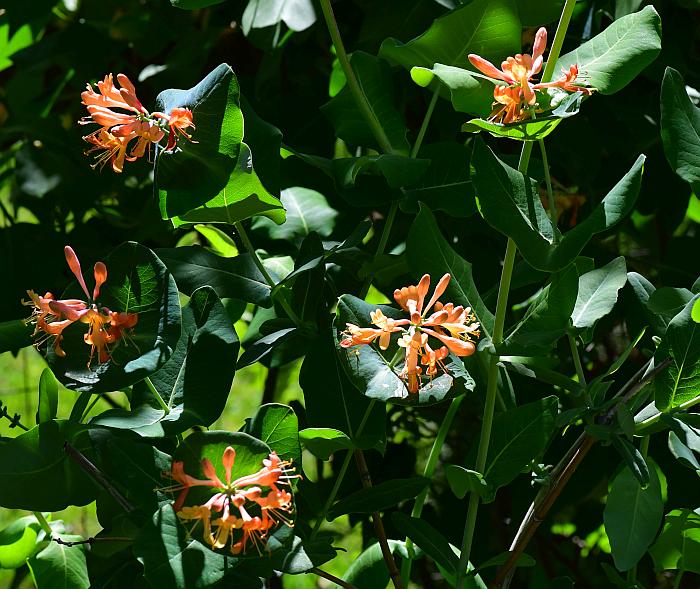Lonicera dioica L.
Limber Honeysuckle

Native
CC = 8
CW = 3
MOC = 17
© SRTurner
Lonicera dioica L.Limber Honeysuckle | |
 |
Native CC = 8 CW = 3 MOC = 17 |
© SRTurner |
|
Family - Caprifoliaceae Habit - Lianas to 4 m or more long, the main stems loosely twining toward the tips, climbing on adjacent vegetation, or more or less trailing on the ground. Stem - Twigs glabrous, the pith hollow, the bark of older branches becoming shredded. Winter buds ovoid but somewhat flattened, glabrous.
Leaves - Opposite, simple, sessile to perfoliate. Blades mostly 3-9 cm long, 2.0-6.5 cm wide, mostly elliptic, rounded or more commonly angled at the base, rounded or more commonly angled or tapered to a bluntly or sharply pointed tip, those of the uppermost 1 or few pairs strongly perfoliate, 1.2-2.2 times as long as wide, the pair broadly elliptic to oblong-elliptic in overall outline, rounded or broadly angled to bluntly pointed tips, sometimes abruptly tapered to minute, sharp points, the upper surface glabrous and bright green, the undersurface glabrous or sparsely to moderately and evenly pubescent with soft, more or less spreading hairs, strongly glaucous.
Inflorescences - Flowers in 1 or 2 whorls of 6 at the branch tips, the flowers sessile, the 2 bracts each 4-6 mm long, free, very broadly triangular, glabrous, the pair of bractlets on opposite sides of each flower minute (0.3-0.5 mm long), free, oblong to broadly ovate.
Flowers - Calyces glabrous, the lobes 0.2-0.4 mm long, semicircular to broadly oblong-rounded, often pale or whitened. Corollas 20-30 mm long, strongly zygomorphic, divided 1/3-1/2 of the way to the base into 2 recurved-curled lips of about equal length, the upper lip shallowly 4-lobed, the lower lip with 1 lobe, the tube weakly swollen or pouched on the lower side near the base, white to lemon yellow and pinkish-tinged (rarely nearly red), not changing color after pollination. Stamens and style exserted from the corolla, slightly longer than the corolla lobes, the style sparsely to densely hairy. Ovaries free.
Fruits - Berries 5-10 mm in diameter, orangish red to red. Flowering - April - June. Habitat - Bases and ledges of bluffs, mesic upland forests, streambanks, fencerows. Origin - Native to the U.S. Lookalikes - Broadly, other vining species of Lonicera, especially L. reticulata. Other info. - This native honeysuckle is not common in Missouri. Occurrences are scattered loosely around the state, with a weak concentration in the northeast quadrant. Beyond Missouri it is found in the northeastern part of the continental U.S., ranging into Canada. This plant and other native honeysuckles are recognized by their vining habit and the leaf pair immediately subtending each inflorescence. These leaves are highly distinctive, being so perfoliate as to appear as a single leaf. This feature is never found on the invasive introduced honeysuckles. L. dioica is further recognized by its pale pink-yellow flowers. The close lookalike L. reticulata lacks any pink coloration on the flowers. Photographs taken in Bel-Nor, St. Louis, MO, 5-2-2023 (SRTurner). |